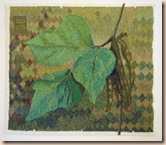Popular tapestry weavers and teachers Tommye Scanlin & Pat Williams return to Sutherland Handweaving Studio this fall for more tapestry weaving instruction.
This time bring at least three designs, or photos, or something torn from a magazine--representations of what you would like to weave into a tapestry. In other words, at least three ideas that would get you started on developing a cartoon suited to tapestry structure. Based on the cartoon, you will be guided in choosing an appropriate warp sett and a suitable color scheme, and encouraged to try new techniques that might be used for this particular design. Then you will start weaving with either a sampler for your next tapestry or possibly the tapestry itself! 
Tommye Scanlin. “Kudzu: Bad Seed,” 24" x 24"(c) 2010
Pre-requisites: You must be able to warp a loom and have taken a beginners' tapestry workshop in your lifetime. What to Bring: Bring your own loom and warp it in the workshop according to your design. A variety of warp and weft yarns will be provided.
For anyone unfamiliar, check out Tommye’s work at http://tapestry13.blogspot.com and Pat’s at http://www.patwilli.com/
TO REGISTER: A deposit of $110 payable to Sutherland will be required to hold your place. Send to Sutherland Handweaving Studio, 122 Riverside Drive, Suite C, Asheville, NC 28801. Do not delay! These workshops fill quickly! The usual cancellation policies apply: If you must cancel more than 30 days prior to start of the workshop, you’ll get your deposit back, less a service charge. If you must cancel within 30 days before the workshop, the deposit will only be refundable if we can fill your place with another student. October 27-29, 2012; 9 am to 4 pm; Class Fee: $220; Supplies Fee: $10 
Pat Williams. “Red Winged Black Birds: Memorial to Their Falling From the Sky,” 59” h x 21 w (c) 2011



